Pair
A rhythmic gymnastics routine performed by two gymnasts with either the same or different apparatus. Pictured are gymnasts from Mitcham gym club in South Australia.
(Picture from Nikki Johnson)
|
|
Passe
The most basic balance position. Leg is turned outwards with thigh at horizontal, knee bent and toes touching the inner knee of the support leg.
(Picture by Rodney Matheson)
|
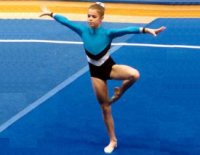 |
Penche
A balance position similar to a needle scale. Free leg is in a verticle splits position and chest is downwards towards the knee of the supporting leg. Both legs are strait and hands should not touch the ground.
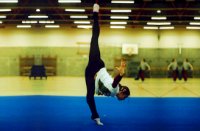 | |
Phrase
A short passage of movement or music.
|
|
Pike
Position with strait, out-stretched legs and a closed hip angle (chest as close to the knees as possible)
|
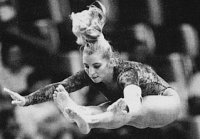 |
Pirouette
Spin or turn.
|
|
pivot
Turn, on the ball of the foot.
|
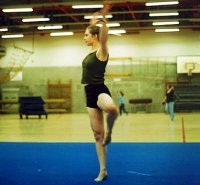 |
Plane
Imaginary, two dimentional surface in which movements are performed. These are the sagittal (lateral), frontal, horizontal, and diagonal planes.
|
|
Planing
The ability of the gymnast to keep the apparatus in the intended plane without deviation.
|
|
Plie
Bend of the knee or knees.
|
|
pose
Aesthetically pleasing momentarily held position.
|
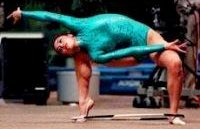 |
posture
The carriage of your body or the way in which you hold yourself.
|
|
pre-acrobatic
Permitted gymnastic acrobatic elements such as rools, splits, chest rolls.
|
|
Preparation
Putting your body in the correct postition for the start of an element (ie: a lunge prepares for a pivot)
(Picture from Nikki Johnson)
|
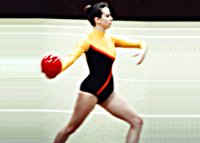 |
push-up arch
similar to a push-up back flexion. From a sitting position with bent legs in front of the boby and one hand behind the body, the gymnasts pushes up into a standing back arch (or back flexion) and then procededs to a standing position.
|
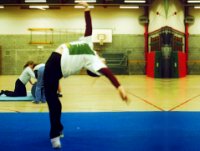 |





